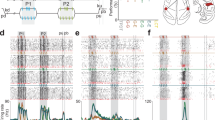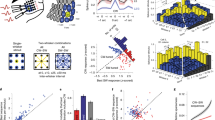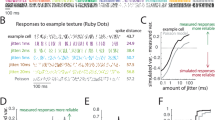Abstract
We sought to determine the neural code(s) for frequency discrimination of vibrotactile stimuli. We tested five possible candidate codes by analyzing the responses of single neurons recorded in primary somatosensory cortex of trained monkeys while they discriminated between two consecutive vibrotactile stimuli. Differences in the frequency of two stimuli could be discriminated using information from (i) time intervals between spikes, (ii) average spiking rate during each stimulus, (iii) absolute number of spikes elicited by each stimulus, (iv) average rate of bursts of spikes or (v) absolute number of spike bursts elicited by each stimulus. However, only a spike count code, in which spikes are integrated over a time window that has most of its mass in the first 250 ms of each stimulus period, covaried with behavior on a trial-by-trial basis, was consistent with psychophysical biases induced by manipulation of stimulus duration, and produced neurometric discrimination thresholds similar to behavioral psychophysical thresholds.
This is a preview of subscription content, access via your institution
Access options
Subscribe to this journal
Receive 12 print issues and online access
$209.00 per year
only $17.42 per issue
Buy this article
- Purchase on Springer Link
- Instant access to full article PDF
Prices may be subject to local taxes which are calculated during checkout







Similar content being viewed by others
References
Romo, R., Hernández, A., Zainos, A. & Salinas, E. Somatosensory discrimination based on cortical microstimulation. Nature 392, 387–390 (1998).
Romo, R., Hernández, A., Zainos, A., Brody, C. & Lemus, L. Sensing without touching: psychophysical performance based on cortical microstimulation. Neuron 26, 273–278 (2000).
Mountcastle, V.B., Steinmetz, M.A. & Romo, R. Frequency discrimination in the sense of flutter: psychophysical measurements correlated with postcentral events in behaving monkeys. J. Neurosci. 10, 3032–3044 (1990).
Recanzone, G.H., Merzenich, M.M. & Schreiner, C.E. Changes in the distributed temporal response properties of S1 cortical neurons reflect improvements in performance on a temporally based tactile discrimination task. J. Neurophysiol. 67, 1071–1091 (1992).
Salinas, E., Hernández, A., Zainos, A. & Romo, R. Periodicity and firing rate as candidate neural codes for the frequency of vibrotactile stimuli. J. Neurosci. 20, 5503–5515 (2000).
Hernández, A., Zainos, A. & Romo, R. Neuronal correlates of sensory discrimination in the somatosensory cortex. Proc. Natl. Acad. Sci. USA 97, 6191–6196 (2000).
Romo, R. & Salinas, E. Touch and go: decision-making mechanisms in somatosensation. Annu. Rev. Neurosci. 24, 107–137 (2001).
Romo, R. & Salinas, E. Flutter discrimination: Neural codes, perception, memory and decision making. Nat. Rev. Neurosci. 4, 203–218 (2003).
Reinagel, P., Godwin, D., Sherman, M. & Koch, C. Encoding of visual information by LGN bursts. J. Neurophysiol. 81, 2558–2569 (1999).
Martínez-Conde, S., Macknik, S.L. & Hubel, D.H. The function of bursts of spikes during visual fixation in the awake primate lateral geniculate nucleus and primary visual cortex. Proc. Natl. Acad. Sci. USA 99, 13920–13925 (2000).
Kepecs, A., Wang, X.J. & Lisman, J. Bursting neurons signal input slope. J. Neurosci. 22, 9053–9062 (2002).
Krahe, R. & Gabbiani, F. Burst firing in sensory systems. Nat. Rev. Neurosci. 5, 13–24 (2004).
Hernández, A., Salinas, E., García, R. & Romo, R. Discrimination in the sense of flutter: new psychophysical measurements in monkeys. J. Neurosci. 17, 6391–6400 (1997).
Siegel, S. & Castellan, N.J. Nonparametric Statistics for the Behavioral Science (McGraw-Hill, New York, 1988).
Connors, B.W. & Gutnik, M.J. Intrinsic firing patterns of diverse neocortical neurons. Trends Neurosci. 13, 99–104 (1990).
Carandini, M. Visual cortex: fatigue and adaptation. Curr. Biol. 10, R605–R607 (2000).
Nowak, L.G., Azouz, R., Sánchez-Vives, M., Gray, C.M. & McCormick, D.A. Electrophysiological classes of cat primary visual cortical neurons in vivo as revealed by quantitative analyses. J. Neurophysiol. 89, 1541–1566 (2003).
Kohn, A. & Movshon, J.A. Neuronal adaptation to visual motion in area MT of the macaque. Neuron 39, 681–691 (2003).
Parker, A.J. & Newsome, W.T. Sense and the single neuron: probing the physiology of perception. Annu. Rev. Neurosci. 21, 227–277 (1998).
Britten, K.H., Newsome, W.T., Shadlen, M.N., Celebrini, S. & Movshon, J.A. A relationship between behavioral choice and the visual responses of neurons in macaque MT. Vis. Neurosci. 13, 87–100 (1996).
Romo, R., Hernández, A., Zainos, A., Lemus, L. & Brody, C.D. Neuronal correlates of decision-making in secondary somatosensory cortex. Nat. Neurosci. 5, 1217–1225 (2002).
Romo, R., Hernández, A., Zainos, A. & Salinas, E. Correlated neuronal discharges that increase coding efficiency during perceptual discrimination. Neuron 38, 649–657 (2003).
Romo, R., Hernández, A. & Zainos, A. Neuronal correlates of a perceptual decision in ventral premotor cortex. Neuron 41, 165–173 (2004).
Hernández, A., Zainos, A. & Romo, R. Temporal evolution of a decision-making process in medial premotor cortex. Neuron 33, 959–972 (2002).
Romo, R., Brody, C.D., Hernández, A. & Lemus, L. Neuronal correlates of parametric working memory in the prefrontal cortex. Nature 399, 470–473 (1999).
Brody, C.D., Hernández, A., Zainos, A. & Romo, R. Timing and neural encoding of somatosensory parametric working memory in macaque prefrontal cortex. Cereb. Cortex 13, 1196–1207 (2003).
Gescheider, G.A., Berryhill, M.E., Verrillo, R.T. & Bolanowski, S.J. Vibrotactile temporal summation: probability summation or neural intergration? Somatosens. Mot. Res. 16, 229–242 (1999).
Talbot, W.H., Darian-Smith, I., Kornhuber, H.H. & Mountcastle, W.T. The sense of flutter-vibration: comparison of human capacity with response patterns of mechanoreceptors afferents from the monkey hand. J. Neurophysiol. 31, 301–334 (1968).
Mountcastle, V.B., Talbot, W.H., Sakata, H. & Hyvarinen, J. Cortical neuronal mechanisms in flutter vibration studied in unanesthetized monkeys. J. Neurophysiol. 32, 452–484 (1969).
Shadlen, M.N. & Newsome, W.T. Noise, neural codes and cortical organization. Curr. Opin. Neurobiol. 4, 569–579 (1994).
Shadlen, M.N. & Newsome, W.T. The variable discharges of cortical neurons: Implications for connectivity, computation, and information coding. J. Neurosci. 18, 3870–3896 (1998).
Ahissar, E., Sosnik, R. & Haidarliu, S. Transformation from temporal to rate coding in a somatosensory thalamocortical pathway. Nature 406, 302–306 (2000).
Poggio, G.F. & Viernstein, L.J. Time series analysis of impulse sequences of thalamic somatic sensory neurons. J. Neurophysiol. 27, 517–545 (1964).
Abeles, M. Corticonics (Cambridge Univ. Press, Cambridge, 1990).
Bialek, W., Rieke, F., Vansteveninck, R.R.D. & Warland, D. Reading a neural code. Science 252, 1854–1857 (1991).
Bair, W., Koch, C., Newsome, W.T. & Britten, K. Power spectrum analysis of bursting cells in area MT in the behaving monkey. J. Neurosci. 14, 2870–2892 (1994).
deCharms, R.C. & Zador, A. Neural representation and the cortical code. Annu. Rev. Neurosci. 23, 613–647 (2000).
Draper, N. & Smith, H. Applied Regression Analysis 2nd edn.(Wiley, New York, 1966).
Press, W.H., Flannery, B.P., Teukolsky, S.A. & Vetterling, W.T. Numerical Recipes in C 2nd edn. (Cambridge Univ. Press, Cambridge, 1992).
Green, D.M. & Swets, J.A. Signal Detection Theory and Psychophysics (Wiley, New York, 1966).
Acknowledgements
The research of R.R. was supported by an International Research Scholars Award from the Howard Hughes Medical Institute and grants from Consejo Nacional de Ciencia y Tecnología and Dirección del Personal Académico of the Universidad Nacional Autónoma de México. C.D.B. is supported in part by the US National Institutes of Health (grant R01-MH067991).
Author information
Authors and Affiliations
Corresponding author
Ethics declarations
Competing interests
The authors declare no competing financial interests.
Supplementary information
Supplementary Fig. 1
Example rasters from a neuron that responded to each stimulus cycle with a burst of spikes. (PDF 104 kb)
Rights and permissions
About this article
Cite this article
Luna, R., Hernández, A., Brody, C. et al. Neural codes for perceptual discrimination in primary somatosensory cortex. Nat Neurosci 8, 1210–1219 (2005). https://doi.org/10.1038/nn1513
Received:
Accepted:
Published:
Issue Date:
DOI: https://doi.org/10.1038/nn1513
This article is cited by
-
Direct contribution of the sensory cortex to the judgment of stimulus duration
Nature Communications (2024)
-
Generalised exponential-Gaussian distribution: a method for neural reaction time analysis
Cognitive Neurodynamics (2023)
-
A biomimetic neural encoder for spiking neural network
Nature Communications (2021)
-
A continuum of invariant sensory and behavioral-context perceptual coding in secondary somatosensory cortex
Nature Communications (2021)
-
Electrocorticographic changes in field potentials following natural somatosensory percepts in humans
Experimental Brain Research (2019)



